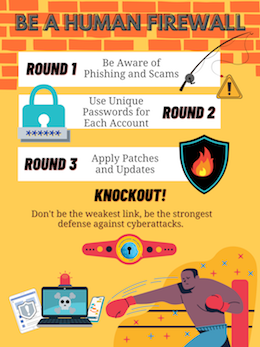You can be the weakest link OR you can be the strongest defense, regardless of where you are accessing online information. As much as we would like to believe it, strong digital defenses, like anti-malware, are not enough. Without you acting as a human firewall, you, your data, and your devices are essentially defenseless.
How can you be a human firewall?
Today passwords need to be more original and complex. Hackers are more creative with phishing and scams, and an unpatched device is a vulnerable device. It is up to you to combat cyber attacks.
Below are some simple steps you can take to be better secured.
Phishing and Scams
Due to remote learning/teaching/working, phishing and scams are on the rise so it is more important than ever to be on your guard. According to NYU’s Center for Cybersecurity, since March of 2020, there has been an 11% increase in cyber attacks.
You can be targeted through phone calls, text and instant messages, social media, and emails (also known as phishing). The four goals of scamming are stealing from victims, including intellectual property, research data, and institutional information, performing identity theft, purchasing items, and getting victims to click or download malicious software.
Scammers know that humans are the weakest link when it comes to cybersecurity and this is where social engineering comes into play. More information on social engineering and what to look for.
Trust your instinct. Think twice before clicking on links or sharing personal information, including on social media. If you think you are being phished, report it to Google and delete the message.
Passwords/Passphrases
- Implement strong, unique passwords for every account and device. This is your chance to get creative with the spelling, spacing, and inclusion of characters. Remember, longer is stronger, so consider using a passphrase, like “Gr33n3gg5&Ham!”. Visit How to Create and Protect Strong Passwords for more information.
- With different passwords for each account you want to make it hard on hackers, not on you, so use a password manager. LastPass, KeePass, 1Password are all examples of password managers that will safely store all of your passwords. Many are free and can generate strong passwords. All you need to do is memorize one password to access the rest. Find a password manager that is highly rated and one that you trust and feel comfortable using.
- If you ever think that any of your passwords may have been compromised, report it to ITS and change that password immediately.
Patches and Updates
Any device that you use to access university data, including reading emails, must meet minimum security standards. Included in these standards is the requirement to apply patches and updates. If you have never updated your device, or have questions, submit a ticket to the ITS Support Center for assistance.
Patches fix problems in your operating system, the basic program that runs your computer.
Unpatched devices can be especially vulnerable. You will want to install all critical and security-related updates as soon as possible. To properly put the update into effect, you will need to restart your computer. If your device is UC-managed patches and updates are automatically installed, so you do not need to worry. Refer to Installing Updates for more information.
Being a human firewall is a commitment, it is up to you to be the strongest defense against cyber attacks.
Video Resources
Social Engineering by Habitu8, The Security Awareness Video Company (2:12)
Passwords by Habitu8, The Security Awareness Video Company (2:41)
DIY Password Method (or creating good passwords) by Habitu8, The Security Awareness Video Company (1:41)

